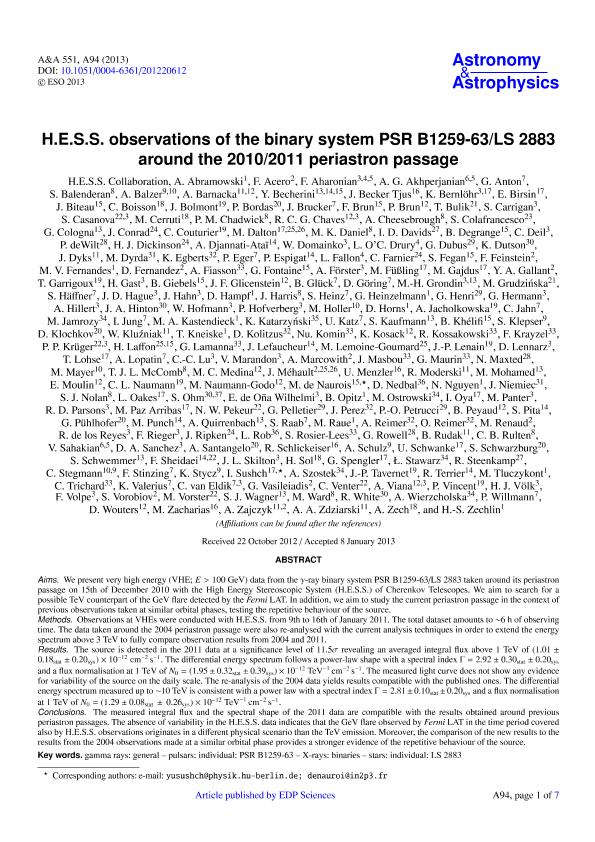Artículo
H.E.S.S. observations of the binary system PSR B1259-63/LS 2883 around the 2010/2011 periastron passage
Abramowski, A.; Acero, F.; Aharonian, F.; Akhperjanian, A.G.; Anton, G.; Balenderan, S.; Balzer, A.; Barnacka, A.; Becherini, Y.; Becker Tjus, J.; Bernlöhr, K.; Birsin, E.; Biteau, J.; Boisson, C.; Bolmont, J.; Bordas, P.; Brucker, J.; Brun, F.; Brun, P.; Bulik, T.; Carrigan, S.; Casanova, S.; Cerruti, M.; Chadwick, P.M.; Chaves, R.C.G.; Cheesebrough, A.; Colafrancesco, S.; Cologna, G.; Conrad, J.; Couturier, C.; Medina, Maria Clementina

Fecha de publicación:
03/2013
Editorial:
EDP Sciences
Revista:
Astronomy and Astrophysics
ISSN:
0004-6361
Idioma:
Inglés
Tipo de recurso:
Artículo publicado
Clasificación temática:
Resumen
Aim. In this paper we present very high energy (VHE; E>100 GeV) data from the \gamma-ray binary system PSR B1259-63/LS 2883 taken around its periastron passage (15th of December 2010) with the High Energy Stereoscopic System (H.E.S.S.) of Cherenkov Telescopes. We aim to search for a possible TeV counterpart of the GeV flare detected by the Fermi LAT. In addition, we aim to study the current periastron passage in the context of previous observations taken at similar orbital phases, testing the repetitive behavior of the source. Methods. Observations at VHE were conducted with H.E.S.S. from 9th to 16th of January 2011. The total dataset amounts to around 6 h of observing time. Results. The source is detected in the 2011 data at a significance level of 11.5\sigma\ revealing an averaged integral flux above 1 TeV of (1.01 \pm 0.18_{stat} \pm 0.20_{sys}) \times 10[elevado a la]{-12} cm[elevado a la]{-2}s[elevado a la]{-1}. The differential energy spectrum follows a power-law shape with a spectral index \Gamma = 2.92 \pm 0.30_{stat} \pm 0.20_{sys} and a flux normalisation at 1 TeV of N_{0} = 1.95 \pm 0.32_{stat} \pm 0.39_{sys}) \times 10[elevado a la]{-12} TeV[elevado a la]{-1} cm[elevado a la]{-2} s[elevado a la]{-1}. The measured lightcurve does not show any evidence for variability of the source on the daily scale. Conclusions. The measured integral flux and the spectral shape of the 2011 data are compatible with the results obtained around previous periastron passages. The absence of variability in the H.E.S.S. data indicates that the GeV flare observed by Fermi LAT in the time period covered also by H.E.S.S. observations originates in a different physical scenario than the TeV emission. Additionaly, new results compared to those obtained in the observations which were performed in 2004 at a similar orbital phase, further support the hypothesis of the repetitive behavior of the source
Archivos asociados
Licencia
Identificadores
Colecciones
Articulos(IAR)
Articulos de INST.ARG.DE RADIOASTRONOMIA (I)
Articulos de INST.ARG.DE RADIOASTRONOMIA (I)
Citación
Abramowski, A.; Acero, F.; Aharonian, F.; Akhperjanian, A.G.; Anton, G.; et al.; H.E.S.S. observations of the binary system PSR B1259-63/LS 2883 around the 2010/2011 periastron passage; EDP Sciences; Astronomy and Astrophysics; 551; 3-2013; 1-7
Compartir
Altmétricas



